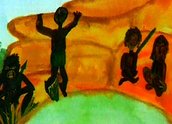


My Mother’s Country Part 2 (2001)
Synopsis
My Mother’s Country is a personal account of the Coniston Massacre of 1928, in two parts.
Curator’s notes
My Mother’s Country – Part 2 continues to tell the story of the Coniston Massacre of 1928 but in more detail, thus allowing the audience to be transported into the situation in which the Indigenous peoples were killed. My Mother’s Country – Part 2 deals more with the physicality of the story of the Coniston Massacre of 1928, with family members walking around the rock holes and other places where relatives were at the time they were attacked by the punitive police party. White ghost gums grow in the area where the people were killed, and the storyteller tells us that the ghost gums have grown from the spirit of the murdered. The family takes care of the area of the white ghost gums, making sure it is kept clean, treating the site with great sensitivity.
The importance of films like My Mother’s Country is that through the survivors of the massacres and the oral histories passed through family heritage, we get a sense of how much time and energy was necessary to execute these kinds of atrocities. In other words, these are not arbitrary acts of violence, but intentional. The re-enactments give the story physicality by allowing us to view actual people in the situations being spoken about in the story. The paintings enhance aspects of the story, like people camping around a rock hole when they were intruded upon. The very intimate, personal and emotional aspects of the story are captured through the re-enactment, and the paintings then provide us with context. The true importance of the film though, is that in the telling of this story and other stories like it, the silent victims of the massacre are at last given a voice. The film itself ends with a call for reconciliation and the need to apologise to those who were murdered.
- Overview
- Curator’s notes
- Video 3 clips

- Principal credits
- Find a copy
- Make a comment
- Map
- Add your review



